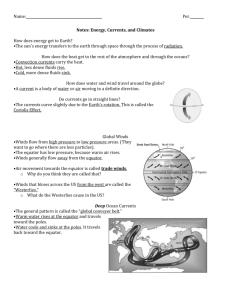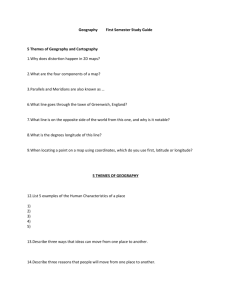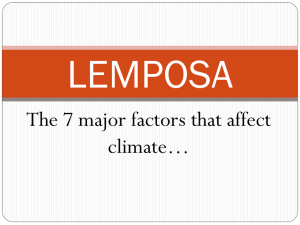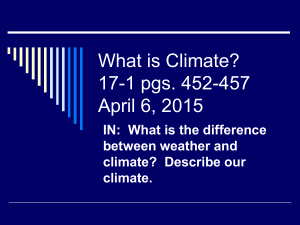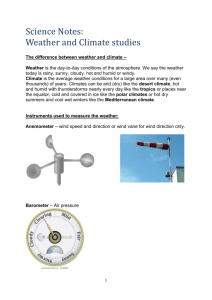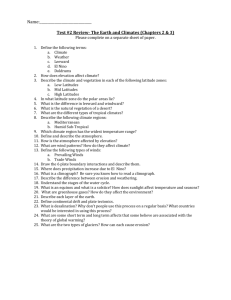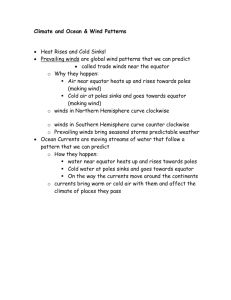Factors affecting Climate
advertisement
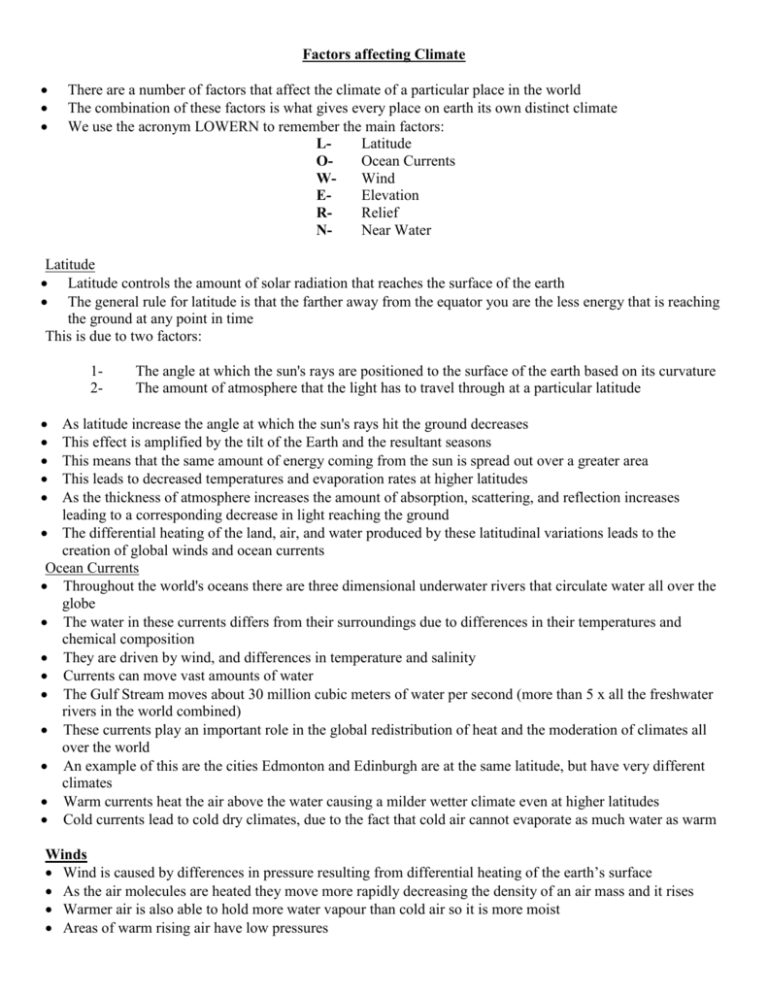
Factors affecting Climate There are a number of factors that affect the climate of a particular place in the world The combination of these factors is what gives every place on earth its own distinct climate We use the acronym LOWERN to remember the main factors: LLatitude OOcean Currents WWind EElevation RRelief NNear Water Latitude Latitude controls the amount of solar radiation that reaches the surface of the earth The general rule for latitude is that the farther away from the equator you are the less energy that is reaching the ground at any point in time This is due to two factors: 12- The angle at which the sun's rays are positioned to the surface of the earth based on its curvature The amount of atmosphere that the light has to travel through at a particular latitude As latitude increase the angle at which the sun's rays hit the ground decreases This effect is amplified by the tilt of the Earth and the resultant seasons This means that the same amount of energy coming from the sun is spread out over a greater area This leads to decreased temperatures and evaporation rates at higher latitudes As the thickness of atmosphere increases the amount of absorption, scattering, and reflection increases leading to a corresponding decrease in light reaching the ground The differential heating of the land, air, and water produced by these latitudinal variations leads to the creation of global winds and ocean currents Ocean Currents Throughout the world's oceans there are three dimensional underwater rivers that circulate water all over the globe The water in these currents differs from their surroundings due to differences in their temperatures and chemical composition They are driven by wind, and differences in temperature and salinity Currents can move vast amounts of water The Gulf Stream moves about 30 million cubic meters of water per second (more than 5 x all the freshwater rivers in the world combined) These currents play an important role in the global redistribution of heat and the moderation of climates all over the world An example of this are the cities Edmonton and Edinburgh are at the same latitude, but have very different climates Warm currents heat the air above the water causing a milder wetter climate even at higher latitudes Cold currents lead to cold dry climates, due to the fact that cold air cannot evaporate as much water as warm Winds Wind is caused by differences in pressure resulting from differential heating of the earth’s surface As the air molecules are heated they move more rapidly decreasing the density of an air mass and it rises Warmer air is also able to hold more water vapour than cold air so it is more moist Areas of warm rising air have low pressures Winds result from the earth trying to equalize pressure from areas of high pressure to those with a low pressure across a pressure gradient An example of this is off and on shore breezes Theoretically global wind patterns would be two large convection cells with warm air rising at the equator and falling at the poles which in turn would flow back to the equator However, other forces affect the rising and falling of air on the earth’s surface (ex Coriolis Force) The Coriolis Force deflects wind to the right in the northern hemisphere and to the left in the southern Convection cells form where warm air coming from the equator meets cold air moving in the opposite direction creating a high pressure system as the air sinks These subtropical highs occur at approximately 30o and polar fronts occur at approximately 60o The descending air of the subtropical highs leads to two wind patterns on the surface, the trade winds (blowing towards the equator) and the westerlies (blowing towards the poles) The trade winds converge near the equator and rise as they are heated creating the area known as the InterTropical Convergence Zone (ITCZ) or doldrums The westerlies meet winds coming from the polar fronts which forces air up creating the subpolar lows These movements lead to three distinct cells of air circulation in each hemisphere Elevation As altitude increases, the corresponding temperature of air decreases It decreases at the environmental lapse rate of 6.4oC/1000m Solar radiation only turns into heat when it is absorbed by a body of matter Lower down in the atmosphere the air is denser and contains more water vapour, air molecules, dust etc. Therefore more energy can be absorbed and turned into heat (longwave radiation) at lower elevations Heat from the surface of the earth moves up through longwave radiation and convection currents (called sensible heat flux) Relief Mountains form a natural barrier that cause air masses to rise As air is forced to rise it expands as gravity decreases, it becomes less dense and cools As air rises from the ground it cools at the Dry Adiabatic Lapse Rate (DALR) which is 10oC/1000m Eventually it will reach an altitude where the moisture in the air condenses forming clouds (Condensation Level) and it will then cool at the Saturated Adiabatic Lapse Rate (SALR) which is about 4.5oC/1000m The SALR is less than the DALR because as moisture condenses heat is released, which slows the cooling As air descends the other side of the mountain it will become unsaturated and the temperature will increase at the DALR This can lead to phenomena such as Chinooks (in the Rockies) and Fohns (in the Alps) Near Water Water bodies provide a source of moisture for the land masses of the world This generally leads to areas close to water having wetter climates except: At high latitudes Strong offshore winds Cold ocean currents Water bodies also have a moderating affect on the climates of the land masses near to them Insolation is unable to penetrate the lithosphere unlike water so it can only heat the surface of the land Water can heat to some depth because of penetration of light and circulation within the water bodies Because of this land can heat up or cool down much quicker than water, so the water has a moderating effect on the land around it In the summer the water acts like an air conditioner to keep the air temperatures cool In the winter water acts like a heater to keep the temperatures from getting too cold This affect is most noticeable in the mid-latitudes where there is a constant onshore wind
